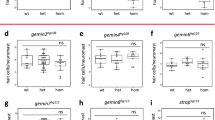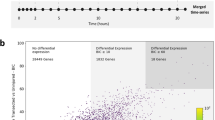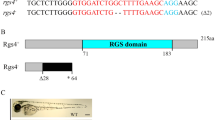Abstract
To better understand hereditary spastic paraplegia (HSP), we characterized the function of atlastin, a protein that is frequently involved in juvenile forms of HSP, by analyzing loss- and gain-of-function phenotypes in the developing zebrafish. We found that knockdown of the gene for atlastin (atl1) caused a severe decrease in larval mobility that was preceded by abnormal architecture of spinal motor axons and was associated with a substantial upregulation of the bone morphogenetic protein (BMP) signaling pathway. Overexpression analyses confirmed that atlastin inhibits BMP signaling. In primary cultures of zebrafish spinal neurons, Atlastin partially colocalized with type I BMP receptors in late endosomes distributed along neurites, which suggests that atlastin may regulate BMP receptor trafficking. Finally, genetic or pharmacological inhibition of BMP signaling was sufficient to rescue the loss of mobility and spinal motor axon defects of atl1 morphants, emphasizing the importance of fine-tuning the balance of BMP signaling for vertebrate motor axon architecture and stability.
This is a preview of subscription content, access via your institution
Access options
Subscribe to this journal
Receive 12 print issues and online access
$209.00 per year
only $17.42 per issue
Buy this article
- Purchase on SpringerLink
- Instant access to full article PDF
Prices may be subject to local taxes which are calculated during checkout








Similar content being viewed by others
References
Tessier-Lavigne, M. & Goodman, C.S. The molecular biology of axon guidance. Science 274, 1123–1133 (1996).
Dickson, B.J. Molecular mechanisms of axon guidance. Science 298, 1959–1964 (2002).
Charron, F. & Tessier-Lavigne, M. Novel brain wiring functions for classical morphogens: a role as graded positional cues in axon guidance. Development 132, 2251–2262 (2005).
Zou, Y. & Lyuksyutova, A.I. Morphogens as conserved axon guidance cues. Curr. Opin. Neurobiol. 17, 22–28 (2007).
Colavita, A., Krishna, S., Zheng, H., Padgett, R.W. & Culotti, J.G. Pioneer axon guidance by UNC-129, a C. elegans TGF-beta. Science 281, 706–709 (1998).
Aberle, H. et al. Wishful thinking encodes a BMP type II receptor that regulates synaptic growth in Drosophila. Neuron 33, 545–558 (2002).
Marqués, G. et al. The Drosophila BMP type II receptor Wishful Thinking regulates neuromuscular synapse morphology and function. Neuron 33, 529–543 (2002).
McCabe, B.D. et al. The BMP homolog Gbb provides a retrograde signal that regulates synaptic growth at the Drosophila neuromuscular junction. Neuron 39, 241–254 (2003).
McCabe, B.D. et al. Highwire regulates presynaptic BMP signaling essential for synaptic growth. Neuron 41, 891–905 (2004).
Wang, X., Shaw, W.R., Tsang, H.T., Reid, E. & O'Kane, C.J. Drosophila spichthyin inhibits BMP signaling and regulates synaptic growth and axonal microtubules. Nat. Neurosci. 10, 177–185 (2007).
Ratnaparkhi, A., Lawless, G.M., Schweizer, F.E., Golshani, P. & Jackson, G.R. A Drosophila model of ALS: human ALS-associated mutation in VAP33A suggests a dominant negative mechanism. PLoS ONE 3, e2334 (2008).
Chang, H.C. et al. Modeling spinal muscular atrophy in Drosophila. PLoS ONE 3, e3209 (2008).
Reid, E. Science in motion: common molecular pathological themes emerge in the hereditary spastic paraplegias. J. Med. Genet. 40, 81–86 (2003).
Salinas, S., Proukakis, C., Crosby, A. & Warner, T.T. Hereditary spastic paraplegia: clinical features and pathogenetic mechanisms. Lancet Neurol. 7, 1127–1138 (2008).
Dürr, A. et al. Atlastin1 mutations are frequent in young-onset autosomal dominant spastic paraplegia. Arch. Neurol. 61, 1867–1872 (2004).
Zhao, X. et al. Mutation in a newly identified GTPase gene cause autosomal dominant hereditary spastic paraplegia. Nat. Genet. 29, 326–331 (2001).
Zhu, P.P. et al. Cellular localization, oligomerization and membrane association of the hereditary spastic paraplegia 3A (SPG3A) protein atlastin. J. Biol. Chem. 278, 49063–49071 (2003).
Scarano, V. et al. The R495W mutation in SPG3A causes spastic paraplegia associated with axonal neuropathy. J. Neurol. 252, 901–903 (2005).
Smith, B.N. et al. Four novel SPG3A/atlastin mutations identified in autosomal dominant hereditary spastic paraplegia kindreds with intra-familial variability in age of onset and complex phenotype. Clin. Genet. 75, 485–489 (2009).
Fusco, C. et al. Hereditary spastic paraplegia and axonal motor neuropathy caused by a novel SPG3A de novo mutation. Brain Dev. 32, 592–594 (2010).
Rainier, S., Sher, C., Reish, O., Thomas, D. & Fink, J.K. De novo occurrence of novel SPG3A/atlastin mutation presenting as cerebral palsy. Arch. Neurol. 63, 445–447 (2006).
Namekawa, M. et al. Mutations in the SPG3A gene encoding the GTPase atlastin interfere with vesicle trafficking in the ER/Golgi interface and Golgi morphogenesis. Mol. Cell. Neurosci. 35, 1–13 (2007).
Sanderson, C.M. et al. Spastin and atlastin, two proteins mutated in autosomal-dominant hereditary spastic paraplegia, are binding partners. Hum. Mol. Genet. 15, 307–318 (2006).
Rismanchi, N., Soderblom, C., Stadler, J., Zhu, P.P. & Blackstone, C. Atlastin GTPases are required for Golgi apparatus and ER morphogenesis. Hum. Mol. Genet. 17, 1591–1604 (2008).
Orso, G. et al. Homotypic fusion of ER membranes requires the dynamin-like GTPase Atlastin. Nature 460, 978–983 (2009).
Hu, J. et al. A class of dynamin-like GTPases involved in the generation of the tubular ER network. Cell 138, 549–561 (2009).
Zhu, P.P., Soderblom, C., Tao-Cheng, J.H., Stadler, J. & Blackstone, C. SPG3A protein atlastin-1 is enriched in growth cones and promotes axon elongation during neuronal development. Hum. Mol. Genet. 15, 1343–1353 (2006).
Park, H.C., Mehta, A., Richardson, J.S. & Appel, B. Olig2 is required for zebrafish primary motor neuron and oligodendrocyte development. Dev. Biol. 248, 356–368 (2002).
Flanagan-Steet, H., Fox, M.A., Meyer, D. & Sanes, J.R. Neuromuscular synapses can form in vivo by incorporation of initially aneural postsynaptic specializations. Development 132, 4471–4481 (2005).
Mintzer, K.A. et al. lost-a-fin encodes a type I BMP receptor, Alk8, acting maternally and zygotically in dorsoventral pattern formation. Development 128, 859–869 (2001).
Schulte-Merker, S., Lee, K.J., McMahon, A.P. & Hammerschmidt, M. The zebrafish organizer requires chordino. Nature 387, 862–863 (1997).
Kobielak, K., Pasolli, H.A., Alonso, L., Polak, L. & Fuchs, E. Defining BMP functions in the hair follicle by conditional ablation of BMP receptor IA. J. Cell Biol. 163, 609–623 (2003).
Tsang, H.T. et al. The hereditary spastic paraplegia proteins NIPA1, spastin and spartin are inhibitors of mammalian BMP signaling. Hum. Mol. Genet. 18, 3805–3821 (2009).
Pyati, U.J., Webb, A.E. & Kimelman, D. Transgenic zebrafish reveal stage-specific roles for Bmp signaling in ventral and posterior mesoderm development. Development 132, 2333–2343 (2005).
Yu, P.B. et al. Dorsomorphin inhibits BMP signals required for embryogenesis and iron metabolism. Nat. Chem. Biol. 4, 33–41 (2007).
Wen, Z. et al. BMP gradients steer nerve growth cones by a balancing act of LIM kinase and Slingshot phosphatase on ADF/cofilin. J. Cell Biol. 178, 107–119 (2007).
Ball, R.W. et al. Retrograde BMP signaling controls synaptic growth at the NMJ by regulating Trio expression in motor neurons. Neuron 66, 536–549 (2010).
Eaton, B.A. & Davies, G.W. LIM kinase1 controls synaptic stability downstream of the type II BMP receptor. Neuron 47, 695–708 (2005).
Yang, Y.S. & Strittmatter, S.M. The reticulons: a family of proteins with diverse functions. Genome Biol. 8, 234 (2007).
Liu, Y. et al. Reticulon RTN2B regulates trafficking and function of neuronal glutamate transporter EAAC1. J. Biol. Chem. 283, 6561–6571 (2008).
Piddini, E. & Vincent, J.P. Modulation of developmental signals by endocytosis: different means and many ends. Curr. Opin. Cell Biol. 15, 474–481 (2003).
O'Connor-Giles, K.M., Ho, L.L. & Ganetzky, B. Nervous wreck interacts with Thickveins and the endocytic machinery to attenuate retrograde BMP signaling during synaptic growth. Neuron 58, 507–518 (2008).
Matsuura, I., Taniguchi, J., Hata, K., Saeki, N. & Yamashita, T. BMP inhibition enhances axonal growth and functional recovery after spinal cord injury. J. Neurochem. 105, 1471–1479 (2008).
Higashijima, S., Hotta, Y. & Okamoto, H. Visualization of cranial motor neurons in live transgenic zebrafish expressing green fluorescent protein under the control of the islet-1 promoter/enhancer. J. Neurosci. 20, 206–218 (2000).
Kimmel, C.B., Ballard, W.W., Kimmel, S.R., Ullmann, B. & Schilling, T.F. Stages of embryonic development of the zebrafish. Dev. Dyn. 203, 253–310 (1995).
Macdonald, R. et al. Regulatory gene expression boundaries demarcate sites of neuronal differentiation in the embryonic zebrafish forebrain. Neuron 13, 1039–1053 (1994).
Shanmugalingam, S. et al. Ace/Fgf8 is required for forebrain commissure formation and patterning of the telencephalon. Development 127, 2549–2561 (2000).
Andersen, S.S.L. Preparation of dissociated zebrafish spinal neuron cultures. Methods Cell Sci. 23, 205–209 (2001).
Tarrade, A. et al. A mutation of spastin is responsible for swellings and impairment of transport in a region of axon characterized by changes in microtubule composition. Hum. Mol. Genet. 15, 3544–3558 (2006).
Acknowledgements
We thank J. Clarke, M. Salanoubat, J. Weissenbach and the Houart, Schneider-Maunoury and Nothias laboratories for discussions and support, S. Llewellyn-Jones, S. Thomas and G. Rodrigues for fish care at King's College London and IFR83/ UPMC, and R. Schwartzmann and V. Georget for the IFR83 imaging platform. We thank the patients' Association Strümpell-Lorrain (A-SL) for their constant support. J.H., a CNRS research fellow, received a senior research fellowship from King's College Charitable Foundation for 2 years in C.H.'s lab. C.F. was supported by fellowships from the FRM and the AFM. This work was supported by research grants to C.H. from the MRC and from AFM and A-SL to J.H.
Author information
Authors and Affiliations
Contributions
J.H. and C.F. performed most experiments and analyzed the data with C.H. J.A.H. and S.S. helped with image acquisition and in situ hybridization and C.H. with transplantation. Half of the study was carried out in the C.H. lab by J.H., S.S.-M. and F.N. A.L. and B.G. welcomed J.H. and C.F. in their labs and gave insightful advice on the project. J.H. and C.H. designed all experiments and wrote the manuscript.
Corresponding authors
Ethics declarations
Competing interests
The authors declare no competing financial interests.
Supplementary information
Supplementary Text and Figures
Supplementary Figures 1–10, and Tables 1 and 2 (PDF 4995 kb)
Supplementary Video 1
Abnormal touch-evoked motility of atlastin (atl1) morphant larvae. Touch-response mobility of 72-hpf (a) control larvae. (MOV 882 kb)
Supplementary Video 1
Abnormal touch-evoked motility of atlastin (atl1) morphant larvae. Touch-response mobility of 72-hpf (b) atl1 morphant larvae. (MOV 3092 kb)
Supplementary Video 1
Abnormal touch-evoked motility of atlastin (atl1) morphant larvae. Touch-response mobility of 72-hpf (c) rescued larvae co-injected with atl1 MO and human ATL1 transcript. (MOV 1289 kb)
Supplementary Video 2
The motility deficit of atlastin (atl1) The motility deficit of atlastin (atl1) morphant larvae is tightly correlated with abnormal branching of spinal motor axons. Touch-response mobility of 4-dpf (a) control (Hb9:GFP; WT). (MOV 1226 kb)
Supplementary Video 2
The motility deficit of atlastin (atl1) The motility deficit of atlastin (atl1) morphant larvae is tightly correlated with abnormal branching of spinal motor axons. Touch-response mobility of 4-dpf (b) atl1 morphant Hb9:GFP; MOatl). (MOV 1607 kb)
Supplementary Video 2
The motility deficit of atlastin (atl1) The motility deficit of atlastin (atl1) morphant larvae is tightly correlated with abnormal branching of spinal motor axons. Touch-response mobility of 4-dpf (c) transplanted (Hb9:GFP; MOatl>WT) mosaic larvae. (MOV 1194 kb)
Supplementary Video 3
The swimming deficit of atlastin (atl1) morphants is rescued by genetic inhibition of BMP signaling. Touch-response mobility of 72-hpf (a) heatshocked and non-injected Tg(hs:DN-BMPRI) transgenic larvae. (MOV 1743 kb)
Supplementary Video 3
The swimming deficit of atlastin (atl1) morphants is rescued by genetic inhibition of BMP signaling. Touch-response mobility of 72-hpf (b) atl1 morphant Tg(hs:DN-BMPRI) larvae which were not submitted to heat shock. (MOV 1835 kb)
Supplementary Video 3
The swimming deficit of atlastin (atl1) morphants is rescued by genetic inhibition of BMP signaling. Touch-response mobility of 72-hpf (c) MOatl/Tg(hs:DN-BMPRI) that were heat-shocked at 32-36 hpf and therefore expressed a dominant-negative version of type-I BMP receptor. (MOV 1273 kb)
Rights and permissions
About this article
Cite this article
Fassier, C., Hutt, J., Scholpp, S. et al. Zebrafish atlastin controls motility and spinal motor axon architecture via inhibition of the BMP pathway. Nat Neurosci 13, 1380–1387 (2010). https://doi.org/10.1038/nn.2662
Received:
Accepted:
Published:
Issue Date:
DOI: https://doi.org/10.1038/nn.2662



